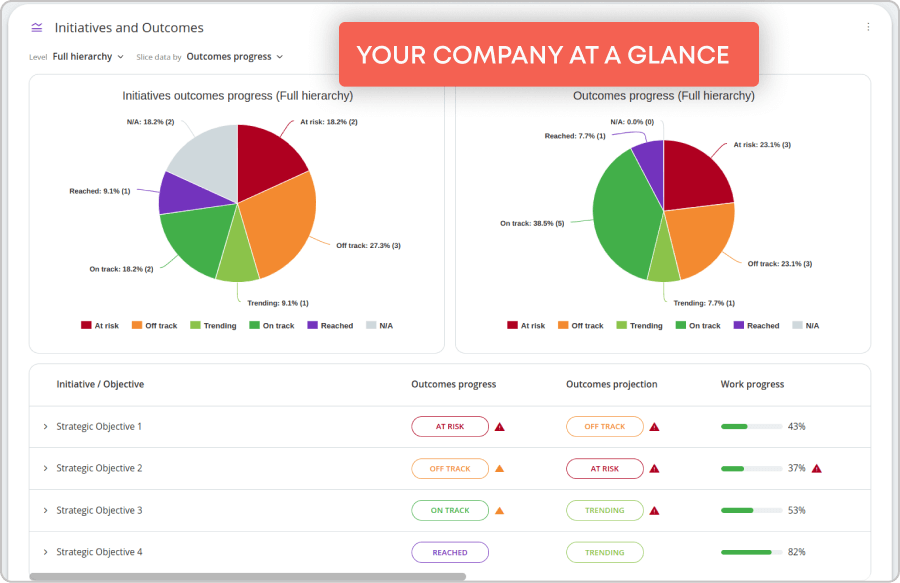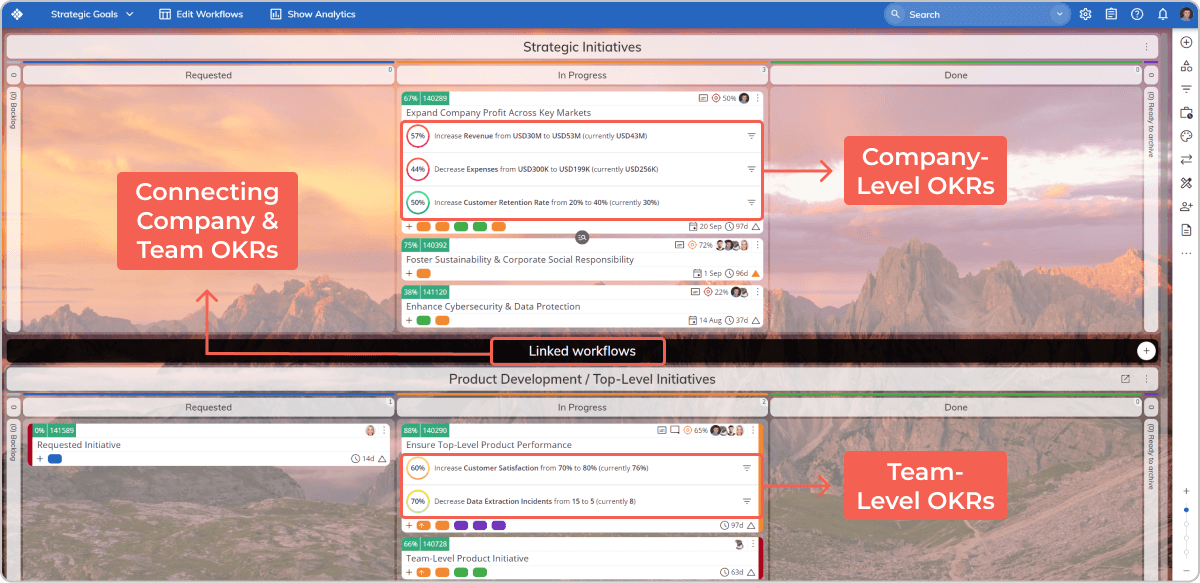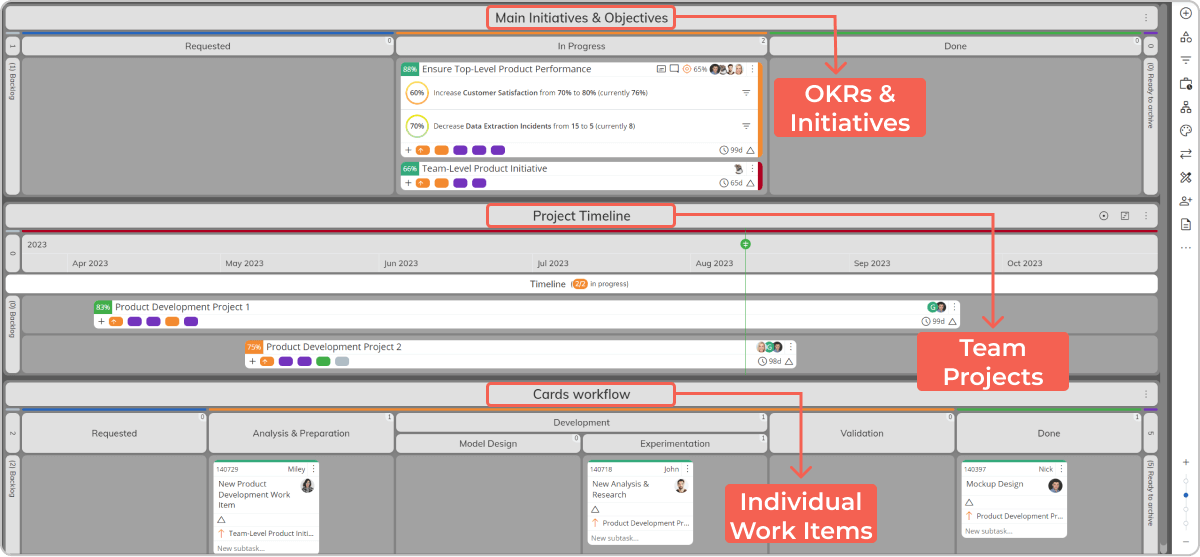Tracking OKRs has never been more essential for aligning goals across an organization. According to the 2024 OKR State of the Industry Report, 97% of respondents now agree that OKRs should directly reflect business strategy. Leaders increasingly see OKRs as more than just goal-setting tools - they are key to bridging the gap between strategy and execution.
We’ll explore 6 best practices for OKR tracking to drive alignment, accountability, and measurable success in your organization.
What Is OKR Tracking?
OKR tracking is the process of regularly monitoring the progress of your OKRs to ensure teams are focused on the right priorities at the right time. It involves updating OKRs with real-time data, using automated check-ins for effortless status updates, and leveraging past performance to predict whether key results are on track.
Important Reasons to Track OKRs in 2025
Tracking OKRs is more than just monitoring progress - it’s about ensuring agility, strategic focus, and effective execution. Here’s why OKR tracking is essential:
Ensures Strategic Alignment
Gain visibility into how different departments contribute to company-wide objectives, ensuring everyone’s work supports the business goals.
Supports Proper Prioritization
Avoid missed deadlines and poorly planned workloads by continuously reassessing and adjusting priorities to focus on what matters most.
Enables Faster Adaptation to Change
Prevent the "set and forget" problem by regularly tracking OKRs, allowing teams to quickly adapt to evolving business needs and market conditions.
Improves Communication of Strategic Priorities
Keep teams informed about shifting priorities so they can adjust their focus and execution accordingly, ensuring alignment across the organization.
Provides Insights into Operational Efforts
Understand how daily tasks and initiatives impact strategic goals, allowing for data-driven optimizations and more effective resource allocation.
6 Best Practices for Effective OKR Tracking
Here are six key practices to optimize OKR tracking, incorporating successful real-world advice from our experience.
1. Define Ownership to Ensure Accountability
To prevent the "set and forget" problem, clearly define ownership of the OKR program. While tracking Objectives and Key Results is a shared responsibility, having designated roles can streamline the process.
Champions (Company-Level Facilitators):
-
Foster transparency by ensuring OKRs are visible across all organizational levels.
-
Establish OKR training sessions and promote best practices.
-
Encourage feedback loops to adapt OKRs to changing business priorities.
Ambassadors (Team-Level Leaders):
-
Support teams in tracking progress and removing roadblocks.
-
Facilitate monthly or quarterly OKR reviews to gather insights.
-
Communicate critical updates to stakeholders and upper management.
» OKR Tracking Tip: Use a centralized workspace to help you ensure clear OKR ownership at both strategic and operational levels.
2. Maintain a Regular Schedule for Tracking Results
Consistently reviewing OKRs is essential to monitor progress and identify roadblocks early. Set up a tracking schedule that fits your team’s workflow:
✅ Daily/Weekly: For high-priority, fast-moving initiatives.
✅ Biweekly/Monthly: For long-term projects requiring ongoing adjustments.
✅ Quarterly: For in-depth performance reviews and strategy refinement.
3. Ensure Transparency of Your OKRs
Every team member should clearly see company-wide and team-level OKRs to understand how their work contributes to larger goals.
-
Company-wide OKR updates should be shared regularly.
-
OKR dashboards should be accessible at all levels to promote transparency.
-
Team meetings should incorporate OKR discussions to keep priorities aligned.
» OKR Tracking Tip: Using designated OKR boards to visualize tactical and operational goals can help you ensure timely updates and strategic alignment.
4. Prioritize Key Results Using Scoring
Not all Key Results (KRs) require the same level of effort. Assigning scores helps teams evaluate progress and prioritize resources effectively.
Common Scoring Method:
- 0.0 – 0.3 → Limited progress.
- 0.4 – 0.6 → Moderate progress.
- 0.7 – 1.0 → Strong performance (average success between 0.6 and 0.7).
Alternative Value-Based Approach:
For large organizations with multiple OKR levels, tracking direct value-based results (e.g., revenue growth, customer retention) can be more effective than numerical scoring.
» OKR Tracking Tip: Creating and linking strategic, tactical, and operational OKRs will help you measure how individual projects contributed to high-level business outcomes.
5. Capture Key Learnings from the OKR Process
OKR tracking isn’t just about measuring success - it’s about learning from both achievements and missed targets.
- Analyze what worked and what didn’t.
- Identify recurring bottlenecks and address inefficiencies.
- Encourage open discussions around why certain Key Results weren’t fully met.
» OKR Tracking Example: A company aiming to increase email subscribers by 25% but achieving only 17% can analyze engagement data to refine future marketing strategies.
6. Choose the Right OKR Tracking Tool
Selecting the optimal OKR platform ensures visibility, automation, and seamless tracking of OKRs at every level. Look for a platform that offers:
✅ Work Visualization: Displays OKRs for teams and management.
✅ Automated Check-ins: Updates goal status with minimal effort.
✅ Performance Insights: Uses historical data to predict progress trends.
✅ Seamless Integrations: Connect OKRs with existing tools like project management systems.
 Global view into strategic goals and their progress using the Initiatives and Outcomes dashboard in Businessmap
Global view into strategic goals and their progress using the Initiatives and Outcomes dashboard in Businessmap
» Real-Life OKR Example: To address misalignment caused by a complex organizational structure, where management lacked visibility into how operational efforts contributed to strategic goals, one of our banking clients implemented Businessmap's digital workspaces. This solution centralized operations, aligned teams with strategy, and enabled leadership to track progress and measure impact.
How Two of The Largest Organizations in the World Save Time & Money with OKRs?
Tracking OKRs in Practice: Best Ways to Use an OKR Tracker
By visualizing work, connecting objectives to execution, limiting focus, and establishing feedback loops, teams can successfully track OKRs and drive meaningful results.
Visualization: Track OKRs & Work Across Management & Team Levels
A key aspect of effective OKR tracking is visualizing objectives and key results across different levels of the organization. A structured work management approach provides a central hub where strategic and team-level OKRs are displayed, creating team alignment and transparency.
Many assume that goal visualization is limited to team-level tracking, but in reality, organizations can scale this practice across all management levels. With a global view of OKRs, you can evaluate ongoing efforts toward the business objectives while teams gain clarity on how their work contributes to company-wide priorities.
For instance, we use Portfolio boards to map and track the progress of our high-level objectives and key results. This central work management hub allows us to see our strategic initiatives at a glance and then use a network of kanban boards to visualize their breakdown across our teams.
 Linking team and company-wide objectives and key results in Businessmap
Linking team and company-wide objectives and key results in Businessmap
Connect OKRs With Actual Work Activities
Tracking OKRs effectively requires more than just monitoring key results - connecting objectives to actual work activities such as initiatives, projects, and tasks. This ensures that teams focus on the right actions that drive business impact.
In our practice, we connect our Portfolio boards to our team work boards. This helps us align OKRs on a team and company level and break down goals into activities that produce an output.
 Linking team goals to work execution in Businessmap
Linking team goals to work execution in Businessmap
Limit Work in Progress: Improve Focus & OKR Tracking
A common challenge in OKR tracking is the temptation to continuously set new goals, leading to diluted focus and difficulty measuring progress. Organizations that put too many OKRs simultaneously often struggle with execution and tracking.
Limiting the number of active OKRs allows your teams to concentrate on the most critical objectives and improve their chances of achieving meaningful results. Just as managing work-in-progress via limits sets a focused number of OKRs and ensures clarity and accountability.
Feedback Loops: Adapt to Changes & Keep Goals Relevant
Tracking OKRs isn’t just about measuring progress - it’s about adapting to change. Without structured feedback loops and check-ins, organizations risk falling out of alignment with evolving market conditions and business needs.
Establishing regular reviews at both the strategic and team levels ensures that OKRs remain relevant, achievable, and impactful.
-
High-Level OKR Reviews: Leadership teams evaluate strategic OKRs, ensuring that objectives align with business needs and adjusting them based on customer and market requirements.
-
Team-Level OKR Reviews: Teams review progress on operational and tactical OKRs, identifying blockers and aligning their work with broader company goals.
Businessmap is the most flexible software
to align work with company goals





 Global view into strategic goals and their progress using the Initiatives and Outcomes dashboard in Businessmap
Global view into strategic goals and their progress using the Initiatives and Outcomes dashboard in Businessmap
 Linking team and company-wide objectives and key results in Businessmap
Linking team and company-wide objectives and key results in Businessmap Linking team goals to work execution in Businessmap
Linking team goals to work execution in Businessmap

